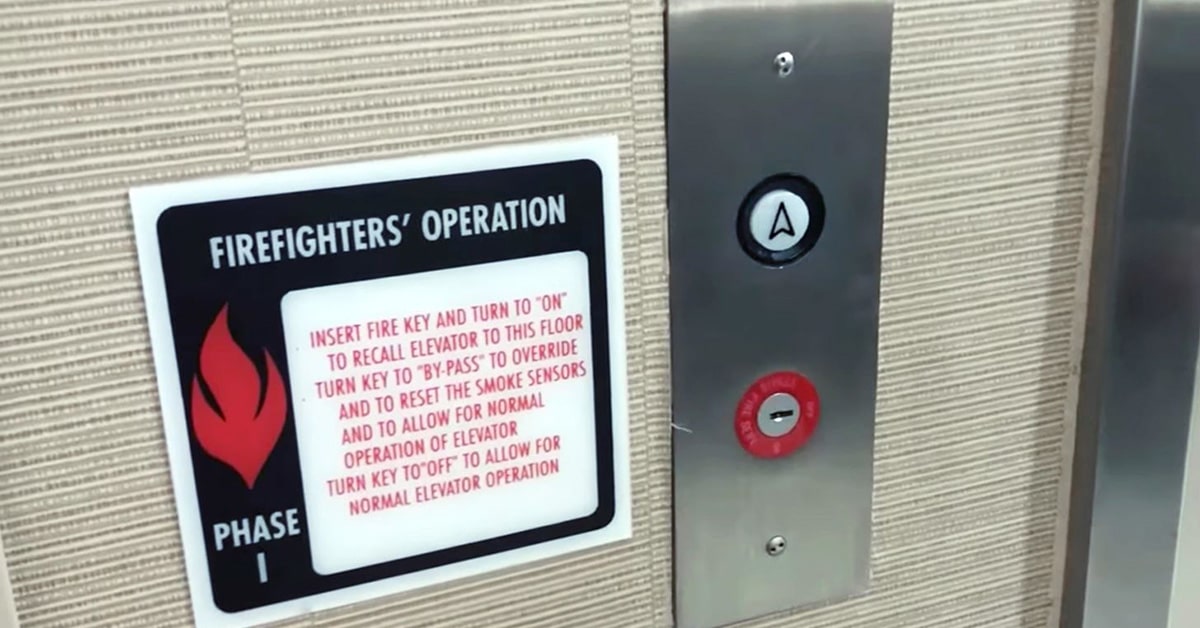Have you ever seen a red key switch in the hall? The one that says, “FIRE SERVICE,” “OFF,” “ON,” and “BYPASS”? Have you ever wondered what it does? We’ll tell you!
First, let’s talk about fire service, what it is and what its purpose is. The first-ever fire service rule was added to the code in 1973. It addressed how the elevator would operate under fire or other emergency conditions. The rule required elevators serving three or more floors or traveling more than 25’ to have a 3-position key switch. At this time, the code also required smoke detectors in the elevator lobbies to recall the elevator if a fire was detected. Let’s jump over to the key switch itself and take a look at what each switch position means.
Phase I
OFF – In the off position, that’s just what it is, off. When the switch is in this position, that means the elevator is running normally, as it should. In the off position, the key can be removed from the switch.
ON – The on position activates the first phase of fire service. The elevator or elevators in this group are recalled to the ground floor. The elevators stop at their designated landing, the same landing as the key switch. As they arrive, you’ll notice them by the distinct sound. There will be a fire service buzzer announcing their arrival and an operating panel light illuminating the inside of the car. Once the cars arrive at the landing, the doors will open, the buzzer will stop, and the cars will sit. At this point, the doors will remain open. In this position, the key IS removable.
Bypass – As we talked about before, there are smoke detectors added to the equation at the same time as the key switch. The bypass position provides the option to bypass the smoke detectors. This allows the elevators to go back to normal operations. It is not intended to be a fix for a faulty smoke detector, it is for emergency use ONLY. In this position, the key is NOT removable.
So now what? Emergency personnel removed the key and entered the elevator. Inside the elevator, they see another switch. This one says, “FIRE SERVICE,” “ON,” and “HOLD”. They’ll use this switch in phase II. The code requires that this switch, the key switch on the outside, and all elevators in the group be keyed alike.
*The phase I feature is required to be tested monthly to make sure it works correctly and is ready in case of an emergency.
Phase II
Now it’s time to talk about the key switch the emergency service personnel see inside the elevator. Imagine that the switch in the car is turned to ON, and the doors are fully closed. Once the elevator is ready to move, it has entered phase II of emergency service.
When the car is ready to move, we set a call to one of the upper floors. Once the car gets there, it stops, but the doors do not open. We must utilize the buttons again to open the door, it is not automatic. If, at any point, we release the open button, the door will immediately stop and close. This is an added safety element to protect firefighters in case the fire is on that floor.
Let’s say the emergency has ceased. Hopefully, it was a false alarm, or the fire has been put out. The final part is getting the cars back to regular operations. So, we make sure the doors are closed, return the switch to the ON position, and return the car to the lobby. Once we’ve made it to the lobby, the key is switched to OFF, and everything is back to normal!
Today we learned about fire service, what it is, and how the elevator is designed for it. Next time we’ll talk about the fire service procedures.
Stay safe!
Authored by Keith Gaut – Field Supervisor and Safety Manager for Bagby Elevator Company
Image by TJElevatorfan/YouTube

